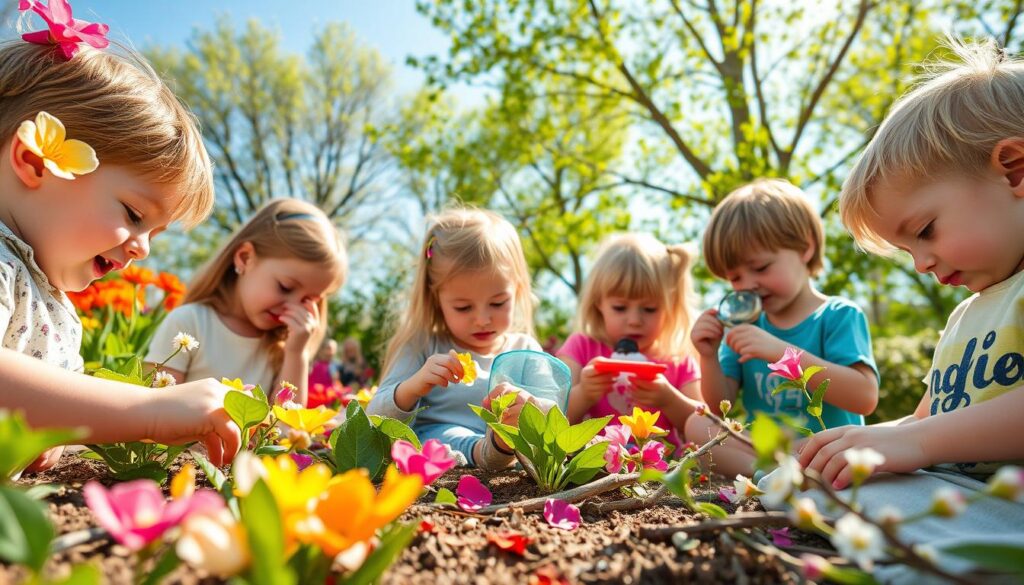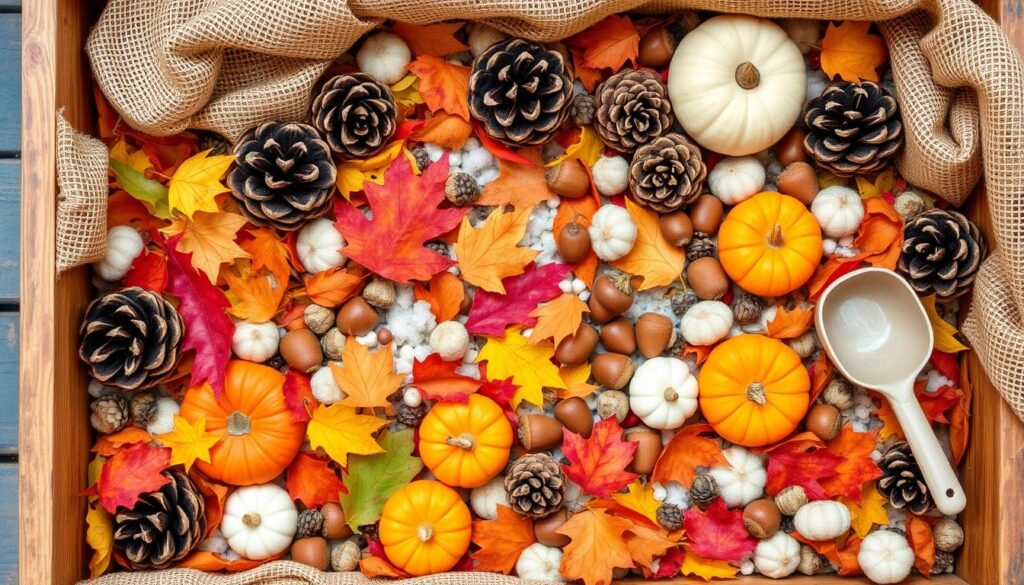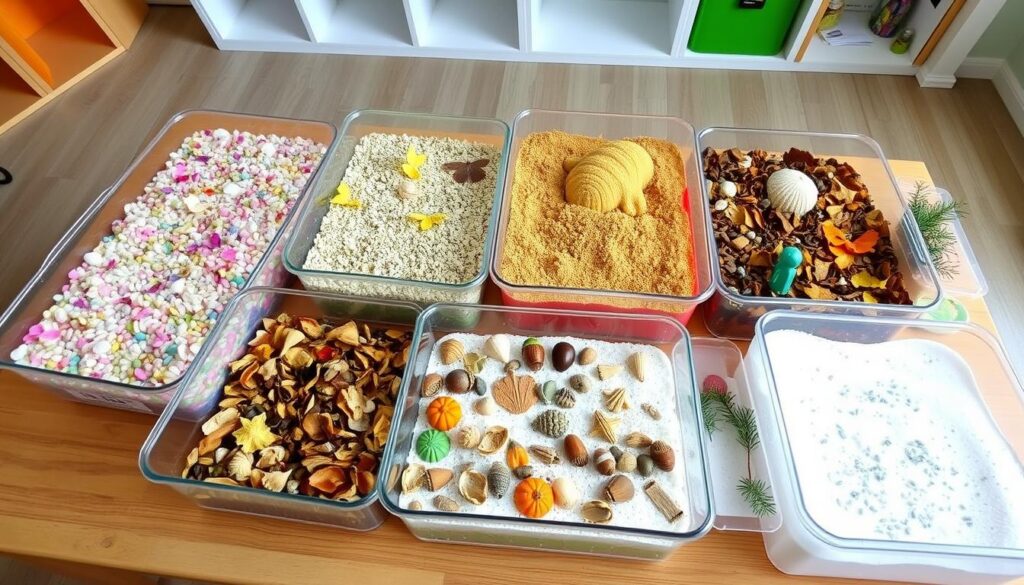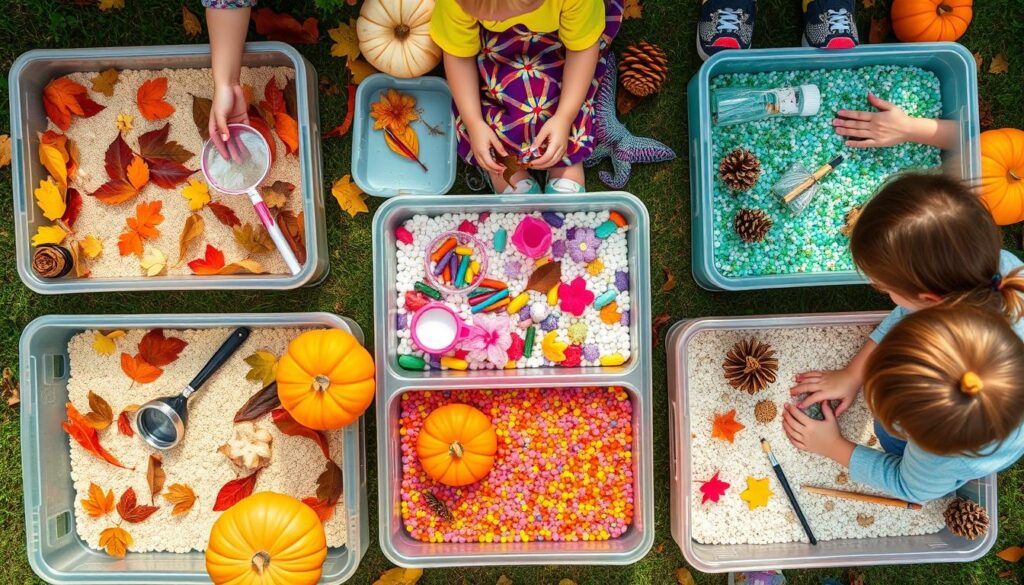Imagine a sunny afternoon in June, with your kids full of joy. They are at a table in the backyard, laughing. They play with cool, vibrant blue water beads. The air smells of new flowers, and bees hum softly. This day is more than just play. It is a celebration that touches all their senses.
Seeing kids dive into engaging sensory activities brings great joy. Sensory play spans all seasons, from spring flowers to winter snow. It opens doors to discovery and enjoyment. We seek creative play ideas that are fun and aid in our kids’ growth. This guide lists 25 sensory activities, one for each season. It turns every day into an opportunity for a new adventure.
Key Takeaways>
- The guide features 25 unique sensory activities spread across all seasons, ensuring year-round fun.
- Designed with young children in mind, including babies, toddlers, and preschoolers.
- Emphasizes affordable and easy-to-source materials, often from dollar stores or thrift shops.
- Activities support fine motor skills, cognitive development, and creativity.
- Safety is prioritized with adult supervision required for all activities.
- Includes ideas for both home and classroom settings, offering versatility.
Why Sensory Play is Important for Children’s Development
Sensory play is crucial for a child’s growth. It helps with basic motor skills and aids cognitive and emotional growth. By playing with different materials, kids learn and discover more. This is a closer look at how sensory play helps in a child’s growth.
Motor Skills Enhancement
Improving motor skills is a big benefit of sensory play. Playing with playdough or in sensory bins helps with fine motor skills. These skills are important for writing and taking care of oneself. Sensory experiences also help make over 1,000 neural connections in a young brain.
Activities like touching and feeling different materials can make fine motor skills 40% better. This shows how playing and learning go hand in hand for kids.
Boosts Creativity and Imagination
Sensory play also makes kids more creative and imaginative. When they play with open-ended materials, their creative thinking grows. Making a mini sand garden or using different textures boosts imagination. This leads to a 65% jump in creative thinking abilities.
Because these activities have no set rules, kids can explore and create freely. This helps grow a strong sense of imagination.
Encourages Problem-Solving Skills
Sensory activities are important for developing problem-solving skills in kids. Tasks like sorting objects or solving puzzles need critical thinking. Research shows kids who do sensory activities get 30% better at solving problems. These activities push their brains, leading to cognitive growth through hands-on experiences.
Knowing these benefits shows why sensory play is key. It helps with motor skills, boosts creativity, and encourages problem-solving. Sensory play builds a strong foundation for all areas of a child’s development.
Spring Sensory Activities for Kids
Spring is a great time for getting kids into fun and colorful sensory activities. We have picked three awesome activities that are perfect for growing minds. They help with development and spark creativity.
Spring Funnel Play
Spring Funnel Play combines spring fun with soothing sounds. Kids use a funnel from the dollar store to pour stuff like rice or chickpeas. They get better at using their hands and solving problems. Simple items can make a big difference in how kids grow.
Plant-a-Flower Sensory Bin
The Plant-a-Flower Sensory Bin brings kids closer to nature. It uses fake flowers and crushed stale cereal for dirt. Playing for 1 hour, kids start to love growing things. They explore different textures and colors. It’s great for playing outside and learning inside.
Caterpillar Pom Pom Push
The Caterpillar Pom Pom Push is great for small hands. Kids push pom poms through holes. They learn about colors and get better at using their fingers. It’s fun and educational, whether it’s a DIY caterpillar or one you buy.

Summer Sensory Activities for Outdoor Fun
Summer is great for kids to enjoy sensory play in the sun. They can play with sand or enjoy cool water activities. These activities are fun and help kids learn by using all their senses. They can make mini sand gardens or feel the chill of ice.
Mini Sand Gardens
Children can make mini sand gardens with a small tray, sand, pebbles, and tiny plants. This activity teaches them about texture and design. By decorating, they use their creativity and improve their fine motor skills. These crafts are a fun way to bring the beach to your home.
Splashing Water Play
Playing with water is perfect on a hot day. Water play activities like sprinklers or splash pads show kids how water moves. Setting up stations with buckets and cups lets them see how water changes shape. It’s fun and helps with learning and developing skills.
Frozen Sensory Play
For a cool down, try frozen play ideas. Freeze toys or colored ice for kids to explore different textures. It’s a way for them to see how things melt. They learn about states of matter and can even learn about colors by mixing ice.
These summer sensory crafts, water play activities, and frozen play ideas offer learning and fun. They ensure kids have a sensory-rich summer.
Fall Sensory Activities for Crisp Days
Fall is a magical time for sensory activities that help kids learn and explore. Fall sensory bins are filled with things like acorns, leaves, and pinecones. They let kids touch various textures and learn about nature. Autumn sensory crafts also provide a creative outlet. Kids use materials like corn husks and pumpkin seeds to make fall-themed art.

The best fall activities include outdoor adventures, crafts, and indoor fun. Apple picking, hiking, and visiting pumpkin patches are top choices. These activities offer cherished agricultural experiences for families. Fall sensory bins are great for tactile learning and education.
Sensory-rich environments help kids grow emotionally. By collecting and sorting leaves, they learn about leaf shapes, colors, and seasonal changes. This ties into studies showing kids who play outside develop better problem-solving skills.
Autumn sensory crafts can make family bonds stronger. Creating a gratitude tree allows for creativity and fosters appreciation. Studies say expressing gratitude strengthens family ties.
In the fall, families love local events like Halloween parades and concerts. These events support community ties and local economies. Outdoor activities also combat childhood obesity. An impressive 70% of families say these activities improve family bonding.
Winter Sensory Activities for Cozy Days
Winter brings the chance for fun indoor activities. They keep spirits high and kids busy. They’re also great for helping kids develop their senses while staying snug at home.

Snow Sensory Bins
Make a mini-winter wonderland with sensory snow play. Just mix shaving foam with baking soda for fake snow that feels real. Add small toys or winter things for even more fun. To make it even more real, mix in a little real snow. It lets kids find cool surprises hidden in the snow.
DIY Salt Dough Crafts
Get creative with DIY salt dough crafts. You only need flour, salt, and water to make the dough. Kids can shape it into holiday figures and paint them after baking. This activity is fun and boosts motor skills. Plus, kids love making their own holiday decorations.
Christmas Soup Sensory Bin
Try making a Christmas Soup Sensory Bin. Use water, cinnamon sticks, cranberries, and pine cones for a holiday mix. Kids will love stirring this “soup” with spoons. They’ll get to feel and smell things that remind them of Christmas. It’s a fun way to mix sensory play with holiday excitement.
These winter activities are not just fun. They’re also important for sensory development in the colder months. Parents and teachers can make any day special with these DIY ideas. They turn a simple day indoors into a learning adventure.
DIY Sensory Bins for All Seasons
Making homemade sensory bins for each season is a fun way to keep kids curious. They can play with sand in the summer and artificial snow in winter. Each season brings new chances for kids to explore with their senses.
You can start with bases like white rice or kidney beans for your DIY sensory ideas. Add different textures with pom poms and clay animals. This mix lets kids feel various sensations. Tools like measuring spoons encourage them to sort and scoop, making playtime richer.

Adding crafty activities to your bins makes them even more exciting. Picture a bin for winter with shiny pipe cleaners and jingle bells. It’s not just about feeling textures but also sparking creativity.
- Spring: Plant-themed bins with beans and plastic flowers
- Summer: Ocean-themed bins with blue-dyed rice and seashells
- Fall: Harvest-themed bins with corn kernels and pumpkin seeds
- Winter: Snow-themed bins with cotton balls and artificial snow
Finding materials for your bins can be easy and cheap. You can use things from home or find bargains at thrift shops. A cheap, used coffee table can become the perfect spot for these bins.
Year-round sensory play helps kids grow in many ways. It improves their motor skills and creativity. It also teaches them to solve problems. Making bins together helps them learn and feel connected to the seasons.
“Creating seasonal sensory bins has revolutionized our crafting time. The kids eagerly look forward to each new theme, and their engagement has been incredible!” – Happy Hooligans Community Member
These bins also encourage sharing on social media. This creates a community where parents post their creative ideas. With so many people contributing, playtime stays fun and educational.
In summary, homemade sensory bins are great for fun and learning all year. They’re an essential tool for any parent focused on child development and keeping kids engaged.
25 Seasonal Sensory Activities for Kids: Fun Ideas for Every Occasion
For a child’s growth, engaging in various sensory activities is key. Our sensory activity guide offers fun and varied seasonal play ideas. These activities keep kids active and learning, whether they’re at home or school.

Our guide shows many ways to engage kids throughout the year. For summer, we suggest over ten fun activities. These include crafting with egg boxes and playing with salt dough. Kids can also bake or make healthy smoothies.
Sensory fun isn’t just about food activities. We recommend using cheap materials you can find easily. Kids can play with kinetic sand or water beads to learn and grow. They can also paint rocks, make bath bombs, or improve their skills with glass gems and pop beads.
Each season brings special activities. In fall, kids can play in leaf piles or create with birdseed. They can also build puppet theaters from cereal boxes. Winter offers snow sensory bins and fun with salt dough for indoor fun.
Our sensory activity guide makes learning fun all year. With over 50 non-food items for sensory bins, there’s something for everyone. Our activities range from spring planting to winter activities. They help children learn and develop in exciting ways.
Creating Sensory Tables for Continuous Engagement
Making sensory tables keeps kids busy and helps them learn. A good setup makes playtime fun and helps kids grow. It’s important to make sure these tables work for all kids, no matter their age or needs.

Choosing the Right Table
Pick a table that’s strong, lasts long, and has room for lots of kids. IKEA has great tables that can change for different play activities. The table should match the kind of play you want, like touching, listening, or looking.
Waterproofing and Maintenance
To keep your table in good shape, use sealants and waterproof covers. This makes cleaning easy and keeps the table safe. Always check the table for damage and clean it often. Pick materials that are simple to clean and keep germ-free.
DIY Project Ideas
DIY projects add fun and uniqueness to sensory tables. Try using cheap stuff like rice, beans, or sand to make cool play areas. Here are some DIY ideas to get you started:
- Nature-Themed Sensory Bin: Use soil, leaves, and small twigs to create a mini forest environment.
- Water Play Table: Incorporate waterproof toys, colored water, and safe kitchen utensils for interactive water play.
- Color Sorting Bins: Use various colored objects for kids to sort and categorize, enhancing their learning and sensory experience.
A good sensory table setup is changing and fits special themes. It makes playtime fun and helps kids learn.
Combining Sensory Play with Learning
Mixing play with learning helps kids enjoy and engage more. Adding sensory activities to daily lessons makes teaching interactive. It lets kids explore and learn about their surroundings in fun ways.
Number and Color Recognition
Using colored beads to sort or counting pasta shapes boosts skills in colors and numbers. Children can enjoy these activities while they learn important concepts. You can easily do sorting with dried pasta at home. Plus, stacking bricks teaches them about numbers as they count and balance.

Alphabet Activities
Learning the alphabet with sensory play is both fun and educational. Searching for letters in bins full of sand or rice helps with letter recognition. Making letters from playdough or in sand is also great for hands-on learning and motor skills.
Nature Exploration
Adding nature into sensory activities gives kids a full learning experience. Doing things like watering plants or playing in a mud kitchen involves many senses. It helps kids understand nature by playing. Using items like stones, leaves, and twigs in sensory bins makes exploring nature even more exciting.
Safety Tips for Sensory Activities
Keeping kids safe during sensory play means being careful with the materials and setup. It’s important to use things that are not toxic and won’t cause allergies. This is true for both homemade playdough and store-bought sand. Parents and caregivers must make sure everything is safe for kids to touch and won’t trigger allergies.
Always watch kids closely, especially with activities that have small parts or could cause choking. Water beads, for example, are great for sensory play. They grow 20 times their size, but their small size requires careful adult watch to stop kids from swallowing them. Dry materials, like chickpeas, are good for the environment and can be used many times. However, you should still keep an eye on them to prevent accidental swallowing.
It’s crucial to regularly check all sensory play items to ensure they’re in good shape and safe. For instance, glow sticks need to be checked for broken glass vials. Checking materials for wear and replacing them when needed keeps playtime safe and fun. Following these precautions helps parents provide enriching and safe sensory play experiences. These experiences support kids’ growth and happiness all year round.








